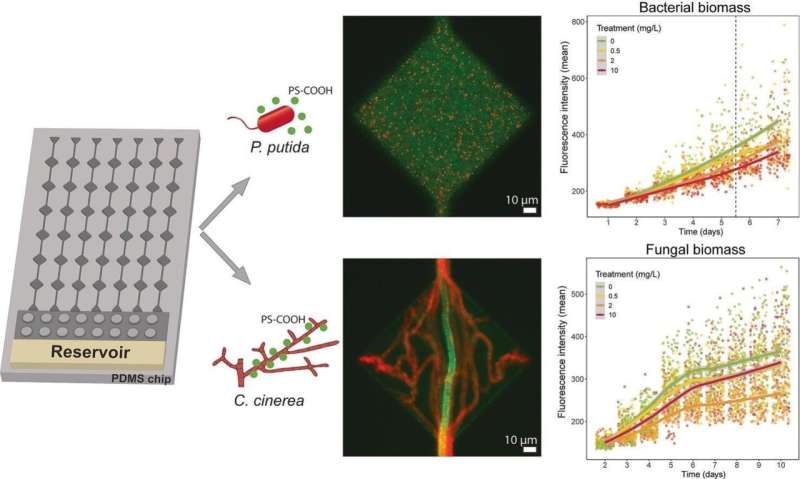This article has been reviewed according to Science X's editorial process and policies. Editors have highlighted the following attributes while ensuring the content's credibility:
fact-checked
peer-reviewed publication
trusted source
proofread
Vacuum cleaner-effect in fungi can hold nanoplastics at bay

Using micro-engineered soil models, researchers at Lund University in Sweden have investigated the effect of tiny polystyrene particles on bacteria and fungi. While these nanoplastics reduced both bacterial and fungal growth, the fungus actually managed to "clean up" their surroundings, thereby easing the effect of the plastics. Their work has been published in Science of The Total Environment.
"Plastic waste is a huge global problem. Whether carelessly discarded into nature, leaking from landfills or scoring from materials such as car tires and synthetic clothes—large amounts of micro- and nanoplastics end up in our soils," says Micaela Mafla Endara, biology researcher at Lund University.
Nanoplastics have been proven to induce toxicity in diverse organisms, yet very little is known how this new pollutant is affecting the soil ecosystem. To study these nanoparticles of polystyrene, the researchers used microfluidic chips, a growth system that allowed them to observe interactions of single cells with the plastics under the microscope.
"At the highest nanoplastics concentration, the fungi caught most of the tiny plastics present in their vicinity, in a process that we labeled the 'vacuum cleaner effect.' Overall, we found that nanoplastics can cause a direct negative effect on the soil microbes. This highlights the need for further studies that can explain how the microbial stress response might affect soil functions," says Micaela Mafla Endara.
The nanoplastic particles clung to the surface of the fungal branches in such a way that the surroundings were almost nanoplastic-free. The fungus cleaned up its surroundings under high concentrations, and could then grow better again. Although the results of the study were confirmed for many conditions, the researchers point out that it might be species dependent.
"This serves as a reminder to reduce our plastic waste and the pollution of soils. Finding fungi that can specifically collect nanoplastics from the soil solution may help other organisms to sustain the pollution better, and perhaps attract bacteria that can break down plastics. The fungal 'vacuum cleaner' is not an easy fix for the problem, but can give a little hope for the future," concludes Edith Hammer, biology researcher at Lund University.
More information: Paola M. Mafla-Endara et al, Exposure to polystyrene nanoplastics reduces bacterial and fungal biomass in microfabricated soil models, Science of The Total Environment (2023). DOI: 10.1016/j.scitotenv.2023.166503
Journal information: Science of the Total Environment
Provided by Lund University





















